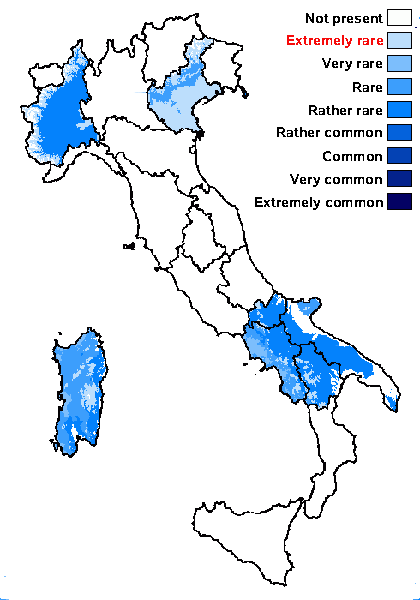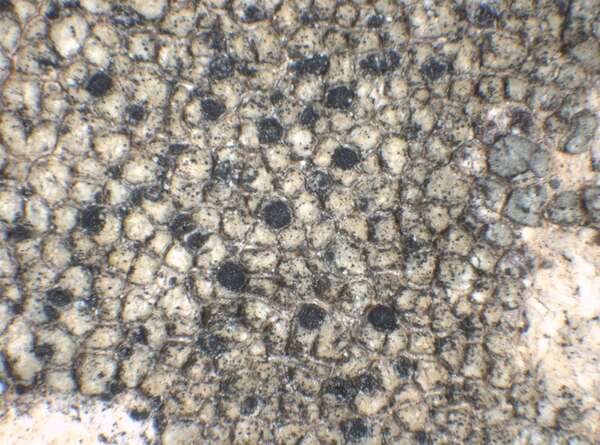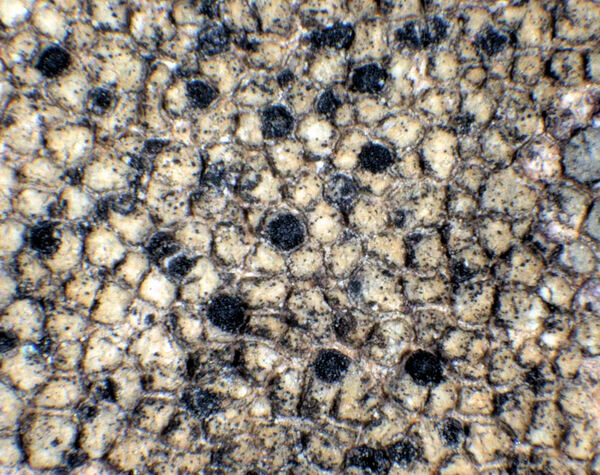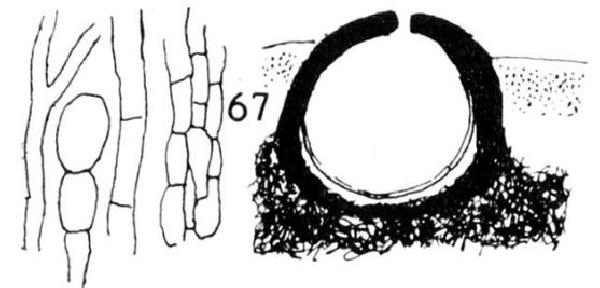Verruculopsis beltraminiana (A. Massal.) Cl. Roux
in Roux & al., Catalogue des Lichens et Champignons lichénicoles de France Métropolitaine, 3e éd.: 1290, 2020. Basionym: Lithocia beltraminiana A. Massal. - Symmicta Lich.: 93, 1855.
Synonyms: Verrucaria beltraminiana (A. Massal.) Trevis.
Distribution: N - VG (TSB 11675), Ven (Caniglia & al. 1999, Lazzarin 2000b), Piem. C - Mol (Nimis & Tretiach 1999, Caporale & al. 2008), Sar. S - Camp (Aprile & al. 2003b), Pugl, Bas.
Description: Thallus crustose, episubstratic, areolate, up to 0.3 mm thick, the areoles sharply angular with brown to black side-walls but usually without a black rim, contiguous, flat, 0.2-0.8 mm wide, whitish to bluish grey, dull. Cortex paraplectenchymatous, overlain by an amorphous epinecral layer; algal layer filling most of thallus; medulla white, with a very thin, brownish basal layer. Perithecia black, numerous, marginal or located between the areoles, deeply immersed, with slightly projecting, convex apices. Involucrellum adpressed to exciple, extending to base-level and more or less incurved beneath; exciple subglobose, 0.2-0.3 mm wide, the wall darker in upper part; hamathecium of periphyses and periphysoids, interascal filaments absent; hymenial gel hemiamyloid, I+ red (I+ blue at very low concentrations of I), K/I+ blue. Asci 8-spored, clavate, I-, fissitunicate, the wall thickened above, with an ocular chamber, dehiscent by extrusion of an endotunica to form a delicate rostrum, Verrucaria-type. Ascospores 1-celled, hyaline, rather broadly ellipsoid, 17-22 x 7-9(-10) µm. Photobiont chlorococcoid. Spot tests: K-, C-, KC-, P-, UV-. Chemistry: without lichen substances.Note: on horizontal to weakly inclined surfaces of calcareous rocks, including walls in small settlements. A critical species, closely related to (but perhaps distinct from) V. lecideoides.
Growth form: Crustose
Substrata: rocks
Photobiont: green algae other than Trentepohlia
Reproductive strategy: mainly sexual
Commonnes-rarity: (info)
Alpine belt: absent
Subalpine belt: extremely rare
Oromediterranean belt: absent
Montane belt: extremely rare
Submediterranean belt: rather rare
Padanian area: extremely rare
Humid submediterranean belt: rare
Humid mediterranean belt: very rare
Dry mediterranean belt: absent

Predictive model
Herbarium samples


P.L. Nimis; Owner: Department of Life Sciences, University of Trieste
Herbarium: TSB (13308)
2003/03/17
Growth form: Crustose
Substrata: rocks
Photobiont: green algae other than Trentepohlia
Reproductive strategy: mainly sexual
Commonnes-rarity: (info)
Alpine belt: absent
Subalpine belt: extremely rare
Oromediterranean belt: absent
Montane belt: extremely rare
Submediterranean belt: rather rare
Padanian area: extremely rare
Humid submediterranean belt: rare
Humid mediterranean belt: very rare
Dry mediterranean belt: absent

Predictive model
| Herbarium samples |


 DOLICHENS
DOLICHENS




